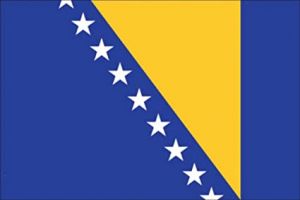Language/Bosnian/Grammar/Adjective-Agreement
| ◀️ Traditional Music and Dance — Previous Lesson | Next Lesson — Comparatives and Superlatives ▶️ |
Introduction
In this lesson, you will learn how to use adjectives in Bosnian and how they agree with the nouns they describe. Adjectives are words that describe or modify nouns. They provide extra information about the people, animals, objects, and concepts that we talk about. In Bosnian, adjectives have to agree in gender, number, and case with the nouns they describe.
The agreement with gender means that the ending of the adjectives change according to the gender of the noun. In Bosnian, there are three genders: masculine, feminine, and neuter. The agreement with number means that the ending of the adjectives change according to whether the noun is singular or plural. The agreement with case means that the ending of the adjectives change according to the grammatical case of the noun in the sentence.
In this lesson, we will cover the following topics:
- Gender and number of adjectives
- Case of adjectives
- Practice exercises
After mastering this lesson, these related pages might interest you: Nouns & Give your Opinion.
Gender and number of adjectives
In Bosnian, the gender of a noun can usually be identified by its ending. Masculine nouns typically end in consonants, while feminine nouns typically end in -a and neuter nouns typically end in -o or -e. However, there are many exceptions, and the gender of some nouns has to be memorized. In order to use adjectives correctly, you must know the gender of the noun.
The endings of adjectives change according to the gender and number of the noun they describe. In the following table, you can see how adjectives change:
| Gender | Singular | Plural |
|---|---|---|
| Masculine | -i | -i |
| Feminine | -a | -e |
| Neuter | -o | -a |
Here are some examples:
- Crveni automobil (Masculine singular, "Red car")
- Crvena torba (Feminine singular, "Red bag")
- Crveno voće (Neuter singular, "Red fruit")
- Crveni automobili (Masculine plural, "Red cars")
- Crvene torbe (Feminine plural, "Red bags")
- Crvena voća (Neuter plural, "Red fruits")
Notice how the endings of the adjectives change according to the gender and number of the noun.
Case of adjectives
In Bosnian, the endings of adjectives also change according to the case of the noun in the sentence. There are seven grammatical cases in Bosnian: nominative, genitive, dative, accusative, vocative, locative, and instrumental.
The nominative case is the case used for the subject of the sentence. The genitive case is used to indicate possession or to show that something is being talked about in a certain way. The dative case is used to indicate the indirect object of a sentence, often answers the question "to whom?" or "for whom?". The accusative case is used to indicate the direct object of a sentence. The vocative case is used to indicate who the speaker is addressing. The locative case is used to indicate where something is located. The instrumental case is used to indicate a means, instrument, or cause.
Let's see how adjectives change according to the case:
| Case | Masculine | Feminine | Neuter |
|---|---|---|---|
| Nominative | -i | -a | -o |
| Genitive | -og | -e | -og |
| Dative | -om | -oj | -om |
| Accusative | -og | -u | -o |
| Vocative | -i | -o | -o |
| Locative | -om | -oj | -om |
| Instrumental | -im | -om | -im |
Here are some examples:
- Crveni automobil (Masculine singular nominative, "Red car")
- Crvenog automobila (Masculine singular genitive, "Of the red car")
- Crvenoj torbi (Feminine singular dative, "To the red bag")
- Crvenu torbu (Feminine singular accusative, "Red bag")
Notice how the endings of the adjectives change according to the grammatical case of the noun.
Practice exercises
Now it's time to practice what you have learned! Try to form sentences using adjectives with different genders, numbers, and cases. Here are some example exercises:
- Translate the following sentence into Bosnian: "The yellow pencil".
- Translate the following sentence into Bosnian: "The black cats".
- Translate the following sentence into Bosnian: "The white dog is running in the park."
- Translate the following sentence into Bosnian: "I am eating a juicy orange".
Answers:
- Žuti olovka.
- Crne mačke.
- Bijeli pas trči u parku.
- Jedem sočnu naranču.
Other Lessons
- Comparatives and Superlatives
- Nouns
- Negation
- Verbs and Conjugation
- Basic Sentence Structure
- Articles and Nouns
- Gender
- Past Tense
- Adjectives
| ◀️ Traditional Music and Dance — Previous Lesson | Next Lesson — Comparatives and Superlatives ▶️ |

